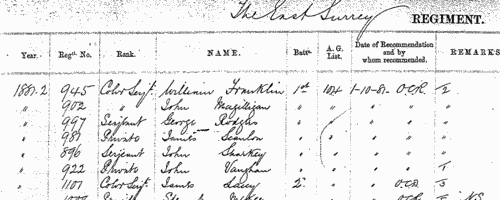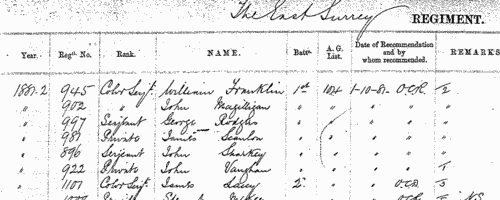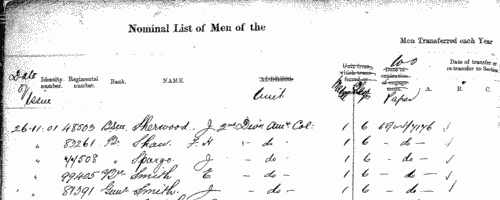Tinsey Surname Ancestry ResultsOur indexes 1000-1900 include entries for the spelling 'tinsey'. In the period you have requested, we have the following 5 records (displaying 1 to 5): Buy all | | | Get all 5 records to view, to save and print for £32.00 |
These sample scans are from the original record. You will get scans of the full pages or articles where the surname you searched for has been found. Your web browser may prevent the sample windows from opening; in this case please change your browser settings to allow pop-up windows from this site. Official Papers
(1700-1702)
The State Papers Domestic cover all manner of business relating to Britain, Ireland and the colonies, conducted in the office of the Secretary of State as well as other miscellaneous records. Includes lists of passes to travel abroad. This abstract covers the period from 1 April 1700 to 4 March 1702, with an appendix of items dating back as early as 1689.
TINSEY. Cost: £4.00.  | Sample scan, click to enlarge

| Treasury Books
(1703)
Records of the Treasury administration in Britain, America and the colonies, for 1703. The text covers a huge variety of topics involving all manner of receipts and expenditure, customs and revenue officials, civil servants, pensioners, petitioners and postmasters figuring particularly among the individuals named.
TINSEY. Cost: £4.00.  | Sample scan, click to enlarge

|  Outstanding soldiers of the Manchester Regiment
(1881-1901) Outstanding soldiers of the Manchester Regiment
(1881-1901)
Each year the best soldiers of the regiment were chosen for long service and good conduct medals. This register gives rank, name, regimental number, and date of recommendation. (The sample scan is from the East Surrey regiment). The register is essentially a register of recommendations, annotated with details of the issue of the medals. Where no gratuity accompanied the medal, the entry is marked 'W. G.' (without gratuity); where, for one reason or another, the medal was not issued, the entry is marked 'N. S.' (not sanctioned) and struck through. The regiment was based on the 63rd Regimental District - Ashton-under-Lyne. The 1st battalion was in Bengal until 1882, when it was transferred to Egypt, adding "Egypt, 1882" to the regimental honours. It returned to England at the end of 1882, and in 1885 was at Shorncliffe; was moved to Ireland in 1888; back to England in 1894; and in 1895 was stationed at Preston. In 1897 the battalion set sail for Gibraltar, and in 1899 was sent on to South Africa, winning the distinctions "South Africa, 1899-1902" and "Defence of Ladysmith". The 2nd battalion embarked for Malta in 1881, was moved from there to Egypt in 1882, joining the 1st battalion in the Egyptian campaign; and from there in October 1882 to India: in 1885 it was stationed at Mooltan, and by 1895 at Dinapore. The 2nd battalion took part in the Miranzai expedition of 1891. It was transferred to Aden in 1897, and back to England in 1898, being moved the following year to Ireland, and then in 1900 to South Africa, also taking part in the Boer war of 1900 to 1902.TINSEY. Cost: £8.00.  | Sample scan, click to enlarge

|  Outstanding soldiers of the Royal Dublin Fusiliers
(1881-1901) Outstanding soldiers of the Royal Dublin Fusiliers
(1881-1901)
Each year the best soldiers of the regiment were chosen for long service and good conduct medals. This register gives rank, name, regimental number, and date of recommendation. (The sample scan is from the East Surrey regiment). The register is essentially a register of recommendations, annotated with details of the issue of the medals. Where no gratuity accompanied the medal, the entry is marked 'W. G.' (without gratuity); where, for one reason or another, the medal was not issued, the entry is marked 'N. S.' (not sanctioned) and struck through. The regiment was based on the 102nd Regimental District - Naas. The 1st battalion embarked for Gibraltar 15 April 1876, and in 1879 was sent on to Ceylon; it returned to Ireland in March 1886, was moved to England in 1893, and by 1895 was stationed at Sheffield. The battalion was sent out to South Africa in 1899 and added "South Africa, 1899-1902" and "Relief of Ladysmith" to the regimental honours. The 2nd battalion embarked for Gibraltar in 1884, went on to Egypt in 1885, and was moved on to India in 1886. It was based at Quetta by 1895. The 2nd battalion was moved to South Africa in 1897. TINSEY. Cost: £8.00.  | Sample scan, click to enlarge

|  British artillerymen fighting in South Africa
(1899-1902) British artillerymen fighting in South Africa
(1899-1902)
The Queen Victoria's South Africa Medal was awarded (after her death, in the event) to all who had served honourably in the various campaigns in the Boer War. Returns were made from each unit, and consolidated into nominal roll, of which this is the one for the Royal Artillery. Confusingly, the ledgers used had originally been printed for a register of men transferred (or re-transferred after mobilization) to 1st Class Army Reserve. All the original column headings were therefore struck through, and the roll was prepared with this information: Date of Issue; Regimental Number; Rank; Name; Unit; Medal (a 1 indicating that a medal was awarded); [number of] Clasps; the reference to the source in the original returns, usually starting with AG for papers in the hands of the Adjutant-General, and 68/Art/ for the Royal Artillery records. The final column, normally left blank, was occasionally used for explanatory remarks.TINSEY. Cost: £8.00.  | Sample scan, click to enlarge

|
Research your ancestry, family history, genealogy and one-name study by direct access to original records and archives indexed by surname.
|








